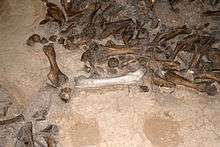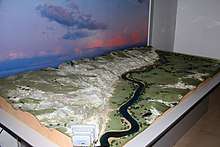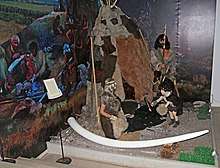Kostyonki–Borshchyovo archaeological complex
The Kostyonki–Borshchyovo archaeological complex is an extended Upper Paleolithic (Aurignacian to Gravettian) site, covering 30 km2 in the area of Kostyonki (also Kostenki) and Borshchyovo (also Borshchevo) on the western middle bank of the Don River in Khokholsky District, Voronezh Oblast, Russia, some 25 km south of the city of Voronezh. It is divided into sites Kostenki-1–21 and Borshchevo-1–5, which are in turn divided into 10 stratigraphical layers.

It is known for its high concentration of cultural remains of anatomically modern humans from the beginning of the Upper Paleolithic era, before 40,000 years ago.[1][2] Finds are on exhibit in situ, at the State Archaeological Museum–Reserve Kostyonki built atop the mammoth bone circle Kostenki 11.[3][4]
History

Mammoth teeth were found at the site from an early time. Cornelis de Bruijn wrote in 1703:
- "In the locality in which we were, to our great surprise, we found many elephant teeth, of which I kept one myself, for the sake of curiosity, but I can not understand how these teeth could get here. True, the Emperor [Peter I] told us that Alexander the Great, passing this river, as some historians assure, reached the small town of Kostenka, about eight versts from here, and that it could very well be that at that time several elephants had fallen, the remains of which are still here today."
The site is also mentioned by Samuel Gottlieb Gmelin in 1768. The settlement name Kostyonki itself is a derivation from кость "bone".
Kostenki-1 was excavated by I. S. Polyakov (1845–1887) in 1879. Further excavations during 1881–1915 were mostly searches for stone tools. Systematic excavations were performed from the 1920s, most notably those led by P.P. Efimenko during 1923–1938.
In the second half of the 20th century it was recognized that there were other sites in the neighbourhood, now labelled Kostenki-1 to Kostenki-21 and Borshchevo-1 to Borshchevo-5. The most famous of these are Kostenki-12 (Volkovska) and Kostenki-14 (Markina Gora).
A 25,000-year-old bone circle structure of at least 60 mammoths, measuring over 12.5 metres (41 ft) in diameter, was discovered at Kostenki in 2020.[5]
Sites

Kostenki-1/2 (site Kostenki-1, layer 2), Kostenki-1/3, Kostenki-6 (Streletskaya), Kostenki-11 and Kostenki 12/3 below the volcanic CI tephra layer are associated to the nontransitional local "Strelets culture", analogous to early Upper Paleolithic cultures from central and western Europe such as the Szeletian culture. This initial cultural development might be attributable to local Neanderthals.[6] Ornaments predating the volcanic eruption, found at Kostenki 17/2 ("Spitsyn culture", 38–32 ka),[7] were apparently perforated by a hand-operated rotary drill or drills; these may suggest that the population was technologically capable of preparing for a volcanic winter.[8] Just above the ash layer sewing needles were found .[9]
Kostenki 1/1, Kostenki 4/2, Kostyonki 8/2 and Kostenki 21/3 belong to the eastern Gravettian (24 to 22 ka). Kostenki 2, Kostenki 3, Kostenki 11-1a and Kostenki-19 belong to the Zamyatino culture (22 to 17 ka). Kostenki 8/2 (Telmanskaya) is eponymous of "Telman culture".[10]
As of 2016, archaeological work is done at Kostenki-14 (Markina Gora), Kostenki-6 (Streletskaya), Kostenki-15 (Gorodtsovskaya), Kostenki-16 (Ugljanka), Kostenki-17 (Spitsynskaya) and Kostenki-21 (Gmelinskaya).[7]
Human remains

In the period around 40-24 kya, a latitudinal clinal pattern of modern/Neanderthal traits was indicated in Europe. The Kostyonki sites are located at the more modern eastward end.
The earliest directly dated human remains from this site are dated to 32,600 ± 1,100 14C years and consist of a tibia and a fibula, with traits classifying the bones as European early modern humans.[11]
In 2009, DNA was extracted from the remains of a male hunter-gatherer from Kostenki-12 who lived circa 30,000 BP and died aged 20–25. His maternal lineage was found to be mtDNA haplogroup U2. He was buried in an oval pit in a crouched position and covered with red ochre.[12] Kostenki 12 was later found to belong to the patrilineal Y-DNA haplogroup C1* (C-F3393).[13]
A male from Kostenki-14 (Markina Gora), who lived approximately 35–40,000 BP, was also found to belong to mtDNA haplogroup U2. His Y-DNA haplogroup was C1b* (C-F1370). The Kostenki-14 genome represents early evidence for the separation of Western Eurasian and East Asian lineages. It was found to have a close relationship to both "Mal'ta boy" (24 ka) of south-east Siberia (Ancient North Eurasian) and to the later Mesolithic hunter-gatherers of Europe and western Siberia, as well as with a basal population ancestral to Early European Farmers, but not to East Asians.[14]
Volcanic ash
A layer of Campanian volcanic ash from about 45,000 years ago has been found above some of the finds, showing that humans inhabited the site before this.[6][15][8]
The Campanian Ignimbrite eruption of the Phlegraean Fields volcano occurred about 39 kya. The explosion of 500 cubic kilometers (120 cu mi) ignimbrite was the largest in the last 200,000 years of European history.[16]
References
- "The era of the great European cultures of the Northern-type hunters". www.iabrno.cz. Czech Academy of Sciences, the Institute of Archaeology in Brno, The Center for Paleolithic and Paleoethnological Research. Retrieved 26 March 2018.
- "Kostenki-12, a memorial to Upper Paleolithic culture in Eastern Europe" (in Russian). Institute of History of Material Culture, RAS. Archived from the original on 12 July 2006. Retrieved 12 January 2007.
- St. Fleur, Nicholas (17 March 2020). "This Mysterious Ancient Structure Was Made of Mammoth Bones". The NewYork Times. Retrieved 17 March 2020.
- https://www.sciencenews.org/article/ice-age-structure-russia-made-mammoth-bones-largest
- "Oldest Circular Structure Discovered – and It's Made of Mammoth Bones". Haaretz. 17 March 2020.
- Anikovich, M. V.; et al. (1 January 2007). "Early Upper Paleolithic in Eastern Europe and implications for the dispersal of modern humans". Science. 315 (5809): 223–226. Bibcode:2007Sci...315..223A. doi:10.1126/science.1133376. ISSN 0036-8075. PMID 17218523.
- Синицын А. А. Ранний верхний палеолит Восточной Европы:украшения и вопросы эстетики () ed. Г. А. Хлопачев, St. Petersburg 2016.
- Anikovich, M. A.; et al. (2007). "Early Upper Paleolithic in Eastern Europe and Implications for the Dispersal of Modern Humans". Science. 315 (5809): 223–226. Bibcode:2007Sci...315..223A. doi:10.1126/science.1133376. PMID 17218523. Retrieved 12 January 2007.
- Hoffecker, John F. (2007-01-12). BBC Science in Action, 12 January 2007.
- Рогачев А. Н., Аникович М. В., Дмитриева Т. Н. 1982. Костёнки 8 (Тельманская стоянка) // Палеолит Костёнковско-Борщёвского района на Дону.
- Higham, T.; et al. (January 2006). "Revised direct radiocarbon dating of the Vindija G1 Upper Paleolithic Neanderthals". Proceedings of the National Academy of Sciences of the United States of America. 103 (3): 553–557. Bibcode:2006PNAS..103..553H. doi:10.1073/pnas.0510005103. ISSN 0027-8424. PMC 1334669. PMID 16407102.
- "DNA analysed from early European". BBC. 1 January 2010. Retrieved 8 May 2010.
- Fu 2016.
- A. Seguin-Orlando et al. (6 November 2014). "Genomic structure in Europeans dating back at least 36,200 years". Science. 346 (6213): 1113–1118. doi:10.1126/science.aaa0114. PMID 25378462.CS1 maint: uses authors parameter (link)
- "Time Out of Africa" (PDF). Archived from the original (PDF) on 3 March 2016. Retrieved 21 November 2014.
- De Vivo, B.; G. Rolandi; et al. (1 November 2001). "New constraints on the pyroclastic eruptive history of the Campanian volcanic Plain (Italy)". Mineralogy and Petrology. Springer Wien. 73 (1–3): 47–65. Bibcode:2001MinPe..73...47D. doi:10.1007/s007100170010.